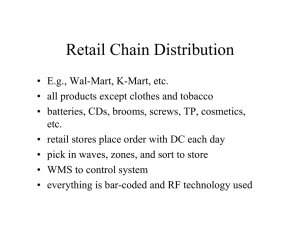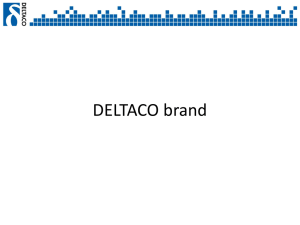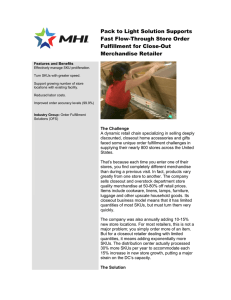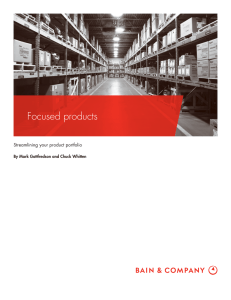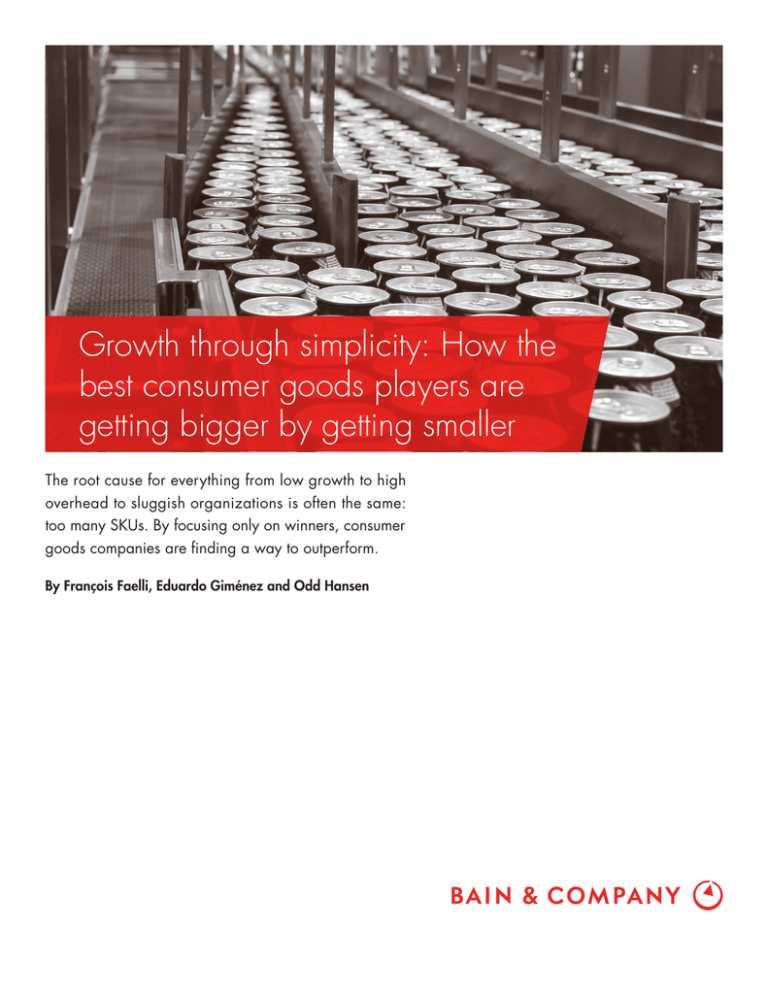
Growth through simplicity: How the
best consumer goods players are
getting bigger by getting smaller
The root cause for everything from low growth to high
overhead to sluggish organizations is often the same:
too many SKUs. By focusing only on winners, consumer
goods companies are finding a way to outperform.
By François Faelli, Eduardo Giménez and Odd Hansen
François Faelli is a Bain partner based in Brussels, Eduardo Giménez is a
Bain partner based in Madrid and Odd Hansen is a Bain partner based in
Copenhagen. All are members of Bain’s Consumer Products practice.
Copyright © 2013 Bain & Company, Inc. All rights reserved.
Growth through simplicity: How the best consumer goods players are getting bigger by getting smaller
The two companies had different goals. A leading meat
(For their full stories, see the sidebars “Are 63 different
producer wanted to expand across many countries in
bottles really necessary?” and “Simply too much sausage.”)
Europe, so it set out to build scale and create efficiency
in its supply chain. A beverage company wanted to
Like those two companies, many consumer goods
close six plants throughout Europe and focus on im-
players, particularly in developed markets, suffer from a
proving the performance of its top-selling brand. Both
host of painful aches that can include stagnant growth,
companies quickly realized that their extensive product
unwieldy supply chains and out-of-control organiza-
assortment had created complexity that was keeping
tional costs. Companies may choose different terms to
them from achieving their goals. There was no getting
describe their symptoms. We hear everything from “low
around a nagging fact: They needed to streamline their
marketing ROI” to “complex and ineffective trade terms
portfolio of SKUs.
system” to “an inability to effectively deploy commercial
strategies at the point of sale.” In addition, we hear
By smartly doing so, the meat producer not only im-
“high conversion costs,” “high overhead” and “low-
proved its supply chain and the beverage company not
capacity utilization.” Despite these different descriptions,
only reduced its manufacturing footprint, but both also
when we dig deep we often find the same root cause
incurred a benefit they didn’t set out to achieve: With
for these symptoms: the overabundance of brands, SKUs
fewer products to push out to the market and support
and product specifications—and constant changes to
on the shelves, they were able to turbocharge growth.
what consumers are offered (see
Figure 1).
Figure 1: Portfolio complexity is often the root cause of symptoms faced by consumer goods companies
Poor in store
execution
High
overheads
AN
W
AV
RG
IZA
LO
HE
TH
O
O
W
Y
GR
in developed markets
TIO
N
Low
marketing
ROI
Brands
SKUs
Specs
Changes
High supply
costs
Low speed
(decisions,
launches)
High Capex
Low purchasing
scale
HIGH
SUP P LY C O S T S
Source: Bain & Company
1
Growth through simplicity: How the best consumer goods players are getting bigger by getting smaller
Why more isn’t more
For consumer goods companies, however, assortment
simplification can dramatically change things. When
done right, it can unlock significant benefits. First and
Over the years, consumer goods companies have in-
foremost—and contrary to conventional wisdom—
stinctively beefed up their portfolios as a way to grow,
selling less often leads to selling more. Revenues for a
amassing offerings to serve every conceivable consumer
food category in Belgium grew by 17% despite a 42%
preference. In doing so, however, they’ve often just
reduction in SKUs. Similarly, a candy category in Sweden
added two different forms of complexity: above-the-
achieved a 19% increase in sales despite selling 18%
skin and below-the-skin. Above-the-skin complexity is
fewer items (see
the proliferation of brands, products and SKUs that’s
Figure 2). In addition to achieving
such revenue gains, a simplified product portfolio often
apparent to shoppers on the store shelf. Below-the-skin
translates to significant supply-chain savings and
complexity is the abundance of product features and
organizational efficiencies.
specifications—variations and nuances in recipes,
ingredients, packaging materials and the like—that are
The trouble is that unlocking such benefits takes time,
not necessarily discernible to shoppers.
patience and careful planning. Perhaps more important,
it requires a new way of thinking. Assortment simpli-
In the past decade, both forms of complexity have steadily
fication, unfortunately, still comes across as counter-
crept into the portfolios of consumer goods companies.
cultural in many consumer goods companies.
In Spain, for instance, Bain research has shown that the
total number of SKUs offered in the consumer packaged
Figure 2: We have seen repeated evidence that “less is more”
20%
19%
17%
14%
Revenue impact
10
3%
5%
4%
8%
0
-4%
-4%
-10
SKU reduction
-10%
-16%
-18%
-42%
-45%
-50%
Champagne
Candy
Soft drinks
Processed
meat
Aniseed
drinks
Beverage
Snacking
France
Sweden
Mexico
Spain
France
Denmark
Belgium
Source: Bain & Company
2
Growth through simplicity: How the best consumer goods players are getting bigger by getting smaller
goods market grew by 40% between 2000 and 2011.
Below-the-skin complexity, on the other hand, results in
Sales per SKU per square meter of store surface, however,
low procurement scale, excessive changeover times or
did not grow commensurately. In fact, most branded
low utilization in manufacturing plants. To top it all,
goods experienced productivity declines, with average
managing an inflated product portfolio also often causes
sales per SKU per 1,000 square meters eroding by more
overhead to grow. Over time, eroded sales and incre-
than 2% over the period.
mental costs harm profits.
Similarly, below-the-skin complexity has somewhat
If the stakes are so compelling and the downsides so evi-
spiraled out of control, as demonstrated by one of our
dent, then why are companies still reluctant to take action?
clients. The company, which we’ll call FoodCo, recently
An inability to move
came to the shocking realization that between 2010 and
2013 its number of recipes grew by 12% and its number
We see two groups of companies out there: those that
of containers grew by 36%. Container caps increased by
are afraid to do something about it or don’t know where
28% and its number of labels grew by 51%. But during
to start, and those that have tried to simplify but have
the same period, its volume shrunk by 2%.
failed to obtain significant and long-lasting results.
In a robust economy, the costs of complexity often are
Even when some companies are aware that SKU and
offset—or ignored—by impressive top-line growth. But
specification proliferation can be damaging, they can’t
when the economic environment cools, as it has in
seem to make the dramatic moves they need to make
Western Europe and other mature markets, complexity’s
to extricate themselves from the situation. The biggest
problems become more evident and the impact of those
reason: consumer goods players believe that their retail
problems can become deadly. Companies that initially
partners favor broad variety—every possible flavor, for-
set out to grow by offering meaningful product diversity
mulation and pack size—and continuous new SKUs on
with more consumption occasions are starting to realize
the shelves. They also fear that if they suggest removing
that they have created only minor variations of a similar
SKUs from their shelf space, that space will be allocated
product or overlapping versions of complementary
to other, more prolific branded players.
products. Eventually, the resulting complexity attacks
growth and profits in its own devious way.
Other factors also contribute to the inertia: The more-ismore thinking is deeply ingrained in marketers and
The proliferation of brands, products and SKUs, for
sales representatives through incentive systems generally
instance, confuses shoppers at a time when studies show
geared toward adding SKUs to shelves. Many supply-
that they make more purchase decisions in stores but
chain decision makers continue to wrongly believe that
prefer to spend as little time there as possible. Above-
all volume counts—that each added SKU ultimately
the-skin complexity also allows low-rotating SKUs to
enhances manufacturing capacity utilization.
steal valuable shelf real estate from best-selling SKUs,
slowly but surely eroding their performance—a problem
Meanwhile, some companies have tried addressing the
that’s further aggravated as shelf space for branded goods
issue but failed to generate material and long-lasting
shrinks with the rise of private labels and smaller-format
results. Among these, we typically see companies that
channels like convenience stores.
embarked on a dire rationalization or cutting-the-tail
3
Growth through simplicity: How the best consumer goods players are getting bigger by getting smaller
Are 63 different bottles really necessary?
A beverage company sold its products throughout Europe but its supply chain and manufacturing
facilities were woefully local. Each site produced beverages for a single country. The company
knew it could improve its utilization efficiency by consolidating volumes. Doing so would give the
beverage producer enough scale to take advantage of multiple-country production and distribution,
and would free up capacity to introduce new products that the markets would welcome.
The company set a course for rationalizing its operations. It started by investigating which
SKUs were either costly to produce or nearly redundant from the standpoint of below-the-skin
complexity, analyzing everything from recipes to bottle sizes to packaging options. The goal
was identifying which were causing the biggest pain points in its manufacturing lines and to
determine how to harmonize SKU specification so it could pool more volumes across markets in
finished and sourced goods.
This exercise allowed the company to see just how inefficient it had become. For example, it sold one
of its main brands in 63 different bottles across European markets, with some varying only slightly from
others in size or color. It found ways to reduce that to 20 bottles—a step that allowed it to improve
procurement options (it could consolidate volumes and use fewer suppliers) and boost productivity by
concentrating production across fewer factories and producing larger batches. It also learned that it
was using four slightly varying recipes for a specific beverage sold in four neighboring countries. By
settling on a single recipe, it could enjoy benefits of scale by pooling sourcing and production, and
could sell the same beverage to different countries by pasting on a single label that accommodated
the different languages.
exercise that failed to effectively mobilize employees
streamline or accelerate their portfolio, nor eliminate
and was quickly abandoned. We also see companies
painful-to-produce SKUs in an attempt to reduce costs.
that have a siloed, one-sided approach. A marketing
Similarly, they can’t beat complexity if they tackle it from
executive may make the well-reasoned choice to delist
only one side of the company.
a SKU but it won’t really happen without the supplyFor most consumer goods players to win over the long
chain decision makers on board—and vice versa.
term, they must join forces across the organization to
Breaking the vicious cycle
revive growth by focusing on better-selling SKUs while
reinvigorating profits by reducing complexity. Eventually
The only way for companies to radically and success-
this should translate into fewer but fully supported
fully simplify their portfolio is to realize that they can
brands; fewer but fully activated SKUs; fewer but better
benefit from growth and profit if they adopt a joint,
and longer-lasting innovations; and fewer but fully at-
all-encompassing approach. Companies can’t beat
scale product specifications. It also should mean fewer
complexity if they focus on attacking only one aspect:
changes initiated by fewer people (see
They can’t just cut low-rotating SKUs in an attempt to
4
Figure 3).
Growth through simplicity: How the best consumer goods players are getting bigger by getting smaller
Even as it achieved these gains from attacking below-the-skin complexity, however, the company knew
it was only scratching the surface. Despite the manufacturing and supply-chain improvements, it was
becoming evident that there still were too many SKUs. For example, a convenience store cooler may
have only had space for 10 SKUs. Distributors stocking the shelves, however, continued to load more
than 50 SKUs in their trucks. By the middle of the day, they would run out of the best-selling SKUs and
were left with only the lowest-selling ones to place in coolers.
The company tackled above-the-skin complexity by rationalizing its excess shelf offerings. A channelby-channel analysis of its best-sellers allowed it to triage what to keep on the shelf and to zero in on
where to stock which SKUs. Narrowing its portfolio to only the top sellers by channel in a given
country eased the challenge of sales execution. In one country, the act of paring SKUs down to the
best 12 allowed it to achieve perfect execution, which led the brand to gain market share. In another
market, the company eliminated three entire brands and concentrated on two hero brands. In other
cases, the exercise led to the elimination of entire pack types.
By diving into sales data, the company could identify the product innovations that were most successful
in one market and that were transferrable to other markets. Because the company was freeing up
capacity, it could produce more of those products and sell them elsewhere.
Only by approaching the challenge as a supply-chain, manufacturing and point-of-sale problem do
companies like this beverage producer ease gridlock. All told, the effort led the company to shrink its
overall number of SKUs by 10%. Tail SKUs were cut by nearly half. Focusing on the right products
helped the company achieve 16% gains in revenues-per-SKU. By eliminating its most painful SKUs,
the company also reduced complexity costs by 45%. Now it has a leaner and more flexible organization that keeps constant watch for creeping complexity.
Heroes to the rescue
hero SKUs that have the highest potential to win with
shoppers and retailers today and tomorrow.
Rationalizing an assortment should start with bringing
sales, marketing and supply-chain decision makers
In general, hero SKUs are not just those that are most
together to design the range that will win on the shelf.
important to a company’s business (be it in size, rotation
Most consumer goods companies that aim to simplify
or profits). They also typically include SKUs that are
their portfolio act on instinct: They simply cut under-
most strategic to retail customers and most meaningful
performing SKUs. But there’s a fundamental flaw in
to shoppers. They are the products that help the category
this thinking: It does not generate growth. In occasional
grow. Their success builds on itself. They generate
cases, some delisted SKUs may actually have been
higher volumes that increase scale, leading to bigger
important for channel or retail partners.
margins that finance investment to fuel growth.
Instead of concentrating on cutting off the tail, we
Identifying such critical SKUs requires a careful under-
counsel companies to adopt a more inspirational shelf-
standing of shopper behavior in a category, both now
back view that focuses on the head. They identify critical
and in the future. The fact is, in most categories shoppers
5
Growth through simplicity: How the best consumer goods players are getting bigger by getting smaller
Figure 3: The 10 commandments of best-in-class assortment simplicity
Above-the-skin simplicity
Fewer strategic priorities,
fully supported
1
Be crystal-clear
on your strategy
Fewer SKUs,
fully activated
2
Design your
assortment based
on distinctive
understanding of
category rules
3
Build year-on-year
penetration growth
of your hero SKUs
- Set clear priorities
(categories, markets,
channels and brands)
- Pick only the few
brands that you
can build to scale
- Invest sufficiently
behind your
strategic choices
Below-the-skin simplicity
4
Bigger, better, longerlasting innovations
5
Launch innovations
that build brand
penetration and
improve shelf
productivity
Align with the trade on
a definition of success
to activate core SKUs
by store type
Fewer specs,
fully at scale
Fewer changes made
by fewer people
6
Achieve best relative
cost position on hero
SKUs through scale
and harmonization
across geographies,
brands and categories
8
Put assortment high
on top management’s
agenda to enforce
cross-functional
dialogue and
processes
7
Proactively identify
and minimize
assortment-driven
pain in the
supply chain
9
Embed tools and
rules to manage and
remove complexity
10
Control permissions to
make changes, remove
low ROI activities and
ultimately the FTEs
who create them
Source: Bain & Company
want to choose from a complete range of products, so it
vated and fully supported, fit the bill better than a long
would be ineffective to eliminate all but the single biggest
tail of low-rotating SKUs with limited differentiation,
seller. Companies also need to understand what specific
lifespan or impact over time. Companies that identify
product features contribute to actual growth in their
their hero SKUs are usually able to convince retail
category: Is it another pack size? Is it an extra flavor?
partners that stocking more of them while eliminating
Is the new mango pudding really adding incremental
low-rotating SKUs will be a win-win for both parties.
growth or would it be more effective to focus on the old
strawberry flavor but sell it in different packs to tap
After identifying the fewer core SKUs that can win,
into different occasions?
the next step for most companies is to craft a concrete
plan for how to push and make them grow. We start
Identifying and prioritizing hero SKUs is a powerful
by assessing their room for growth through a set of
way to overcome the typical trade objections. As we
specific tools. For instance, a matrix that plots SKUs
mentioned, many companies are afraid to move. They
based on weighted distribution vs. rate of sales helps
fear that retailers favor new and endless variety on their
pinpoint SKUs that sell well but aren’t fully distributed,
shelf and will retaliate against any company that tries
or those that are largely available but could be refreshed
to play by different rules. But what retailers truly want
to sell faster. We complement that assessment with a
are products that bring traffic to the store (through scale
detailed analysis of store-by-store data for trade customers,
or newness), rotate quickly and nurture some form of
including how to push distribution and grow shelf
distinctiveness. A few hero SKUs, continuously reno-
share in specific key accounts. This helps companies
6
Growth through simplicity: How the best consumer goods players are getting bigger by getting smaller
Simply too much sausage
Did customers really care if a sausage was a few millimeters shorter or thinner than another available
product? For a European meat producer, most of the time, the answer was no.
Still, this meat producer had grown steadily over the decades, regularly and liberally adding new
varieties of sausage to its portfolio, which it sold in a few countries in Europe.
As the company attempted to define how to expand across the continent, however, it realized its
current supply chain wasn’t designed to support an acceleration strategy. With several plants serving
local markets and equipped with generally old technologies, it ran at about 60% utilization. The
company needed a new regional supply-chain model to consolidate its manufacturing footprint, provide
technological upgrades and bring it to scale leadership.
However, the meat producer quickly realized that the new supply chain’s benefits would be lost the
minute it had to produce the company’s existing sausage portfolio, with its host of minor variations in
recipes, forms, sizes, pack types and the like. Portfolio complexity had never been an issue with
underutilized plants and an excess number of lines. It would quickly become a headache, however,
in a supply chain that had to run long batches at full speed to be efficient—and that had to do so
without the possibility of stopping every hour to accommodate slight changes in recipe or product
size. Producing the current portfolio would soon require the addition of new lines and capacity, which
would diminish the entire point of the company’s supply-chain initiative.
The company had no choice. It needed to reduce the number of SKUs it produced. More important, it had
to simplify and standardize the number of unique features each SKU could have. To do this well, it first had
to understand what product features created the biggest trouble in the line and forced it to stop production
for the longest periods of time. In sausages, the answer was changes in recipes, link sizes and pack sizes.
The full extent of their SKU complexity—the vast array of sausage varieties and the toll it was taking—
stunned leaders. Many sausages in the portfolio were only a few millimeters longer or thicker than others.
Standardizing SKUs around common platforms—a path taken long ago by the car industry around common frames—became critical for a strategic overhaul that put the company on the path to rapid growth.
The meat producer, however, did not stop there. In sourcing and procurement, it reconsidered unique
ingredients that were difficult to source and those requiring special treatment. In recipe preparation,
it used more common ingredients, tried to lower the cost of formulations and harmonized recipes.
It also eliminated packaging that needed special handling. In shipping and logistics it reevaluated
SKUs that resulted in low truck utilization and potential space constraints. In addition to these cost-saving
changes, it redirected investments, ensuring that hero SKUs received more support.
By modifying approximately 80% of its SKUs but eliminating fewer than 10%, the meat company can
streamline its manufacturing footprint, operating with half the number of plants at higher utilization
levels and reducing costs by 15%. With better margins to reinvest, trimming the fat from its portfolio
is likely to lead the company to sell more sausage.
7
Growth through simplicity: How the best consumer goods players are getting bigger by getting smaller
Making the organization fit
figure out what they can do from a commercial standpoint to make more of their existing products and shelf
assets. They typically realize that they’ll need to free up
Companies must then make sure their organization
shelf space and support resources to make core SKUs
reflects their simplified assortment. They won’t require
grow. This gives them incentive to delist slow movers
the same number of people to manage a portfolio that
and irrelevant variations in their portfolio. Unlike with the
is now much simpler.
typical tail-cutting exercise, though, there is now a positive
They must also elevate assortment discussions to the
and inspiring reason to do it: It will unlock growth.
top management level to ensure continued alignment
Finally, in addition to transforming their portfolio shape,
and collaboration among sales, marketing and supply
they need to eliminate unnecessary or hidden complexity:
chain on decisions to add, alter or eliminate products.
The product overlaps in specific shopper consideration
They must put in place guidelines and tools to track and
sets, multiple different pack types with high changeover
control complexity, ensuring, for example, that new
costs, or nuances in formulation that take a big toll on
products meet high performance hurdles and make the
procurement costs or plant utilization. When products are
most of existing platforms, or that they stick to a one-
directly competing with one another or costs are too high,
in-one-out rule when introducing a new product.
it’s time to delist or reengineer. Again, the best way to do
The benefits of such an integrated approach are numer-
this is to bring together sales, marketing and supply chain
ous: Companies reduce supply-chain costs and out-of-
decision makers, and have them agree on a number of
stocks on their hero SKUs at the points of sale. They
standard platforms to share among brands and SKUs,
gain more manufacturing capacity and create a more
whether they be ingredients, product forms or packaging
effective organization.
materials. They will also agree on discontinuing SKUs
that are too similar or too painful to produce and can’t be
As many are surprised to learn, they also generate faster
fully reengineered. The only condition: that the changes
growth, outpacing competitors even in slow markets
don’t harm shopper appeal or customer interest.
like Western Europe. Whether that region’s economy
continues at its sluggish pace or gains momentum,
players that have simplified are prepared to win.
8
Shared Ambition, True Results
Bain & Company is the management consulting firm that the world’s business leaders come
to when they want results.
Bain advises clients on strategy, operations, technology, organization, private equity and mergers and acquisitions.
We develop practical, customized insights that clients act on and transfer skills that make change stick. Founded
in 1973, Bain has 48 offices in 31 countries, and our deep expertise and client roster cross every industry and
economic sector. Our clients have outperformed the stock market 4 to 1.
What sets us apart
We believe a consulting firm should be more than an adviser. So we put ourselves in our clients’ shoes, selling
outcomes, not projects. We align our incentives with our clients’ by linking our fees to their results and collaborate
to unlock the full potential of their business. Our Results Delivery® process builds our clients’ capabilities, and
our True North values mean we do the right thing for our clients, people and communities—always.
For more information, visit www.bain.com

